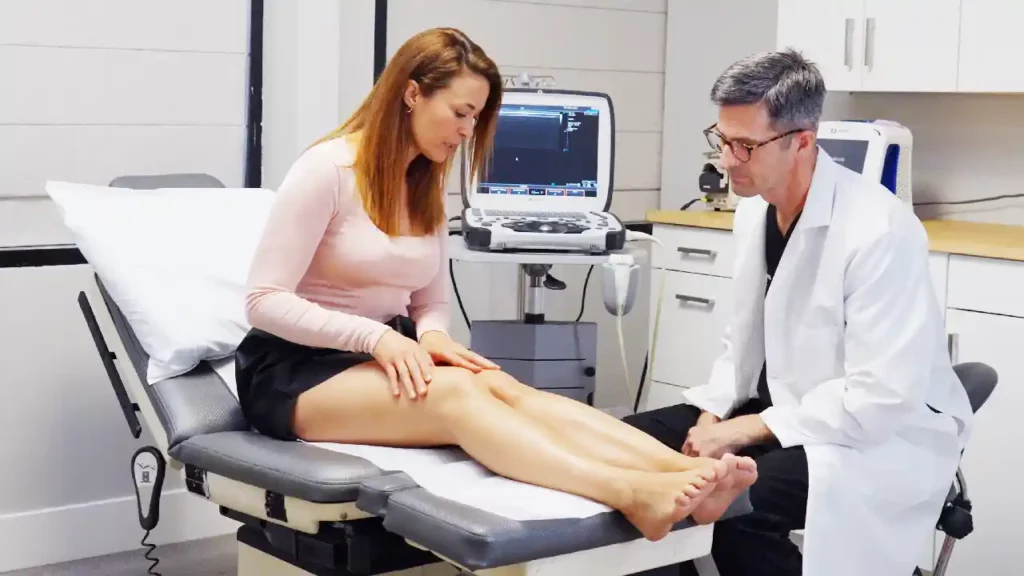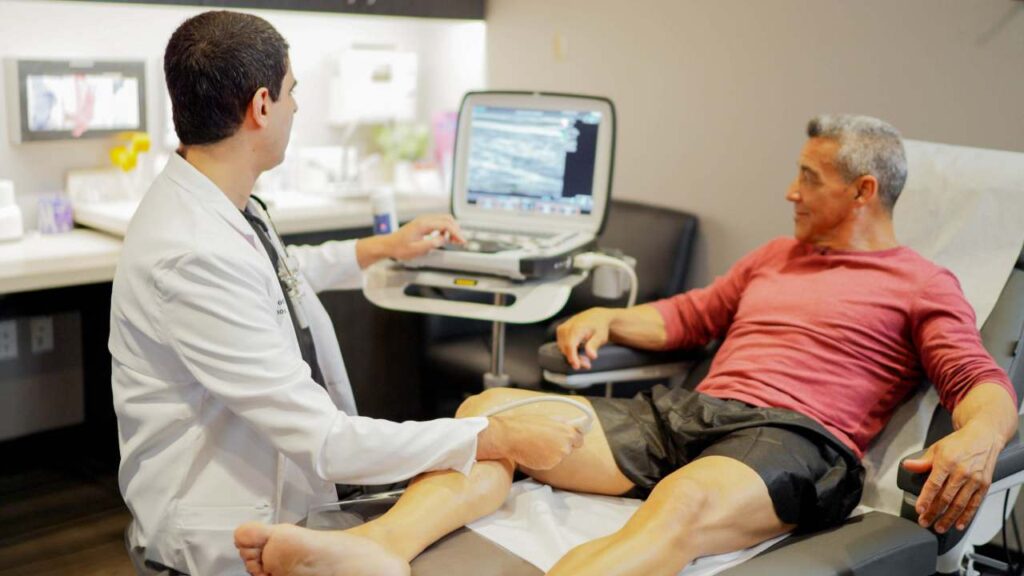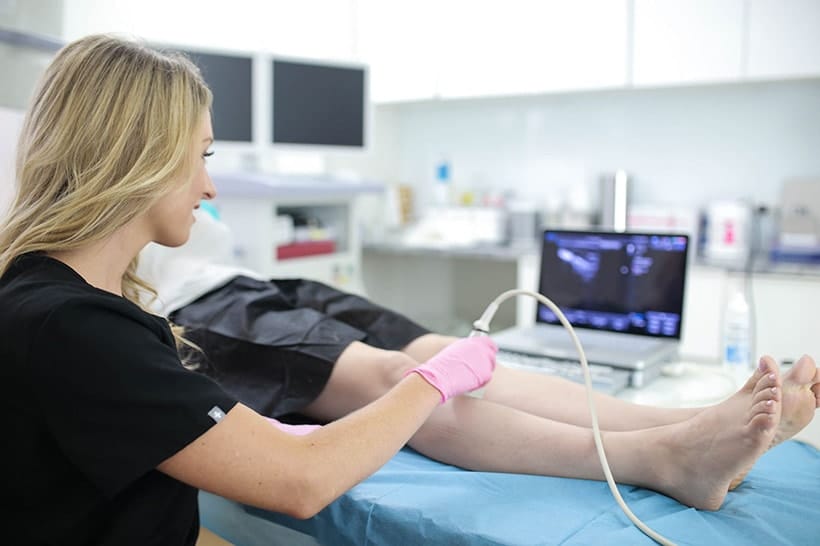What Is Vein Mapping and What Vein Problem Requires It?
If your vein doctor recommended vein mapping, you’re probably wondering what it is. Vein mapping is a Doppler Ultrasound examination that charts the course of your veins, identifying problematic areas and connections. It spots blood clots, broken valves, spider veins, varicose veins, and more. Since each patient has unique venous pathways, vein mapping prevents complications like blood clots breaking loose, and it ensures precise diagnosis and treatment. Board certified vein doctors possess this critical technology, but many cosmetic vein centers don’t. Book an appointment with Harvard-trained vein doctors in California for vein mapping and safe vein treatment.

Is Vein Mapping for Issues in Saphenous Veins or Deep Veins?
Many superficial spider veins and varicose veins stem from issues in a deep vein, like the great saphenous vein, if a valve fails to close. When valves fail in a deeper blood vessel, blood flows in reverse, increasing pressure in the vein. This creates bulging varicose veins and clusters of spider veins you see at the skin’s surface. Vein mapping locates the origin of your damaged veins, so vein doctors can correct it and prevent future vein damage. In the past, surgical extraction was a common varicose vein treatment. Now, the best vein doctors treat most veins inside the body, aided by vein mapping.
Many dermatological vein specialists lack this training, which is why their patients often have recurrences of spider or varicose veins. Vein mapping not only identifies the cause, but it also shows where vein adhesives, sclerosants, and thermal energy will travel when they’re administered. Mapping the connecting veins and problems within them yields lasting results and prevents complications. Choose an accredited vein center, rather than a cosmetic vein center, for cutting-edge vein mapping techniques.
How Much Does Vein Mapping Cost and Does Insurance Cover It?
How much does vein mapping cost? It depends on whether it’s filed through insurance. To acquire insurance coverage for your vein mapping procedure, choose a board certified vein doctor at an accredited vein center. These doctors use FDA-approved treatments that are recognized by insurance. They’re experienced at acquiring maximum coverage for their patients. Some insurance companies require a trial of compression stockings or proof of symptoms prior to covering treatment. Trained vein doctors can provide the evidence you need to gain coverage.
Our California vein centers have a team of insurance specialists who file all paperwork on your behalf and explain your costs prior to treatment. Many of our patients achieve complete coverage for their procedures, including their initial consultation. Most cosmetic vein centers either don’t offer vein mapping, or don’t accept insurance for treatments. But our vein centers partner with all major insurance carriers, including Medicare.
Do You Have to Pay for Local Anesthesia for Vein Mapping?
Insurance coverage can be confusing for patients to understand. In addition to the procedure cost, patients at some vein centers are unpleasantly surprised to receive additional bills for things like general or local anesthesia. This is not a risk with vein mapping at our award-winning vein centers. All of our costs are described clearly prior to treatment. And our procedures do not require general anesthesia. Many of our treatments don’t require local anesthesia either. This includes vein mapping. It’s a painless examination that doesn’t use any anesthesia. When you’re quoted for vein mapping at our vein centers, all costs are explained, so there are no surprise fees.
Does Vein Mapping Increase Varicose Vein Treatment Costs?
Vein mapping and varicose vein treatment are separate but related steps. The best vein doctors use ultrasound technology to map your veins. And they also use ultrasound guidance to administer many of their treatments. This includes treatments like ultrasound-guided sclerotherapy, radiofrequency ablation, endovenous laser ablation, vein adhesives, and mechanochemical ablation. Doctors should not treat a vein problem superficially without considering where it originated. Vein mapping can save patients money since it yields lasting results.
Symptoms like swelling, cramping, heaviness, restlessness, itching, and discoloration in the legs signify that there may be valve failure in a deep vein. If you choose cosmetic treatment for symptomatic veins, the relief will only be temporary. New vein damage can develop until the underlying problem is addressed. Choose a doctor who uses ultrasound guidance to treat the source as well. This will prevent repeated treatment costs that accrue when the source is ignored.
Does Ultrasound Guided Sclerotherapy Involve Vein Mapping?
Ultrasound guided sclerotherapy allows the vein doctor to position the treatment exactly where it’s needed and observe the treatment as it moves through the vein. This helps ensure the sclerosant is successful and travels the entire length and width of the affected area. It also helps prevent the sclerosant from traveling into connecting veins.
Qualified vein doctors can use ultrasound vein mapping prior to sclerotherapy, as well as ultrasound guidance during the treatment. The best vein doctors are trained to manipulate the ultrasound device themselves, rather than using an ultrasound technician. Since ultrasound imaging guides everything from vein mapping to the diagnosis and treatment, it’s important to choose a vein doctor who’s adept at ultrasonography.
Does Endovenous Laser Ablation Require Vein Mapping?
Endovenous laser ablation is often preceded by vein mapping as well. This treatment is different from the surface lasers used on small facial spider veins. Endovenous lasers are applied directly on the vein’s walls, by threading a laser fiber through a hollow catheter inserted in the skin. Vein mapping reveals each blood vessel that needs treatment and the best entry point to insert the catheter. Vein specialists will also use ultrasound to position the device on the vein and monitor the laser as it heats your vein. This enables vein doctors to close veins inside the body, rather than surgically cutting them out.
Do I Need Vein Mapping Before Treating Any Blood Vessel?
Vein mapping is not always required. For instance, a small, facial spider vein that results from sun damage can be treated without mapping your veins. But many varicose veins and spider veins in the legs require a more in-depth approach. Leg veins are prone to valve failure and resultant backward blood flow because of their uphill path to the heart. If you develop a vein problem in your legs, choose a doctor who can use vein mapping to look for valve failure in deeper veins.
Should I Try Compression Stockings Instead of Vein Mapping?
Some patients experience symptom improvement with compression stockings. And some insurance companies require patients to try compression stockings before they’ll cover treatment. But most patients with varicose veins or Chronic Venous Insufficiency need vein treatment to get adequate relief. Compression stockings are not one-size-fits-all. The wrong size could produce insufficient or excessive compression on your veins. Ask our vein experts whether compression stockings are right for you. Vein mapping can help provide the answer. Our vein doctors will conduct a fitting to provide the right amount of compression if you need it.
Where Can I Find Affordable Vein Mapping in California?
The best way to find affordable vein mapping in California is to choose a qualified vein center. Look for a facility that is run by board certified vein doctors and accredited by the Intersocietal Accreditation Commission. Most patients do not need a vascular surgeon. A vein specialist, phlebologist, or minimally invasive vein doctor is often best. These physicians offer proven techniques that insurance companies cover. They also accept the widest range of insurance plans, unlike cosmetic vein centers. Visit our Centers of Excellence in San Diego or San Jose for affordable vein mapping.






